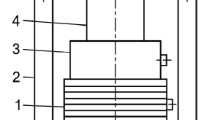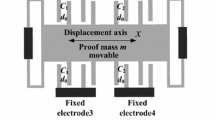Abstract
In-situ self-calibration can fundamentally solve the problem of long-term stability of the accelerometer. The implementation of external integrated micro structure to provide physical excitation has become an effective method to compensate for the long-term drift error of the accelerometer. A closed-loop self-calibration system for accelerometers by integrating sensors and actuators is presented. The piezoelectric MEMS microvibrator acts as an acceleration source, providing a standard acceleration for the accelerometer integrated on it. An optical displacement sensing system consisting of vertical cavity surface emitting laser (VCSEL) and photodiodes (PDs) detects the motion state of the microvibrator to achieve the accurate output by closed-loop control. The self-calibration process of the accelerometer is performed by establishing an error model of the accelerometer and a vibration model of the integrated micro-vibrator. The drift error of the accelerometer is compensated by obtaining the error coefficient and the compensation coefficient. It has been verified that the error of the self-calibrated accelerometer when performing 15 g acceleration output is less than 1.5%.












Similar content being viewed by others
References
Aggarwal P, Syed Z, Niu XA (2008) Standard testing and calibration procedure for low cost MEMS inertial sensors and units. J Navigation 61:323–336
Aktakka EE, Peterson RL, Najafi K (2013) A 6-DOF piezoelectric micro vibratory stage based on multi-axis distributed-electrode excitation of PZT/Si unimorph T-beams (2013) Transducers & Eurosensors XXVII: The 17th International Conference on Solid-State Sensors, Actuators and Microsystems (TRANSDUCERS & EUROSENSORS XXVII). IEEE, pp 1583–1586
Aktakka EE, Woo JK, Egert D et al (2014) A micro vibratory stage for on chip physical stimulation and calibration of MEMS gyroscopes. In: International Symposium on Inertial Sensors & Systems. IEEE, pp 1–2
Bai HW, Wang YW, Dong JZ (2014) Short-term observation data process of all in view based on the Kalman smoothing algorithm. Appl Mech Mater 563, 4
Bekkeng JK (2009) Calibration of a novel MEMS inertial reference unit. IEEE T Instrum Meas 58:1967–1974
Cao Y, Cai H, Zhang S (2011) A new continuous self-calibration scheme for a gimbaled inertial measurement unit. Meas Sci Technol 23:015103
Casinovi G, Sung WK, Dalal M (2012) Electrostatic self-calibration of vibratory gyroscopes. IEEE International Conference on Micro Electro Mechanical Systems (MEMS), pp 559–562
Chen Y, Aktakka EE, Woo JK (2018) On-chip capacitive sensing and tilting motion estimation of a micro-stage for in situ MEMS gyroscope calibration. Mechatronics 56:242–253
Dar T, Suryanarayanan K, Geisberger A (2014) No physical stimulus testing and calibration for MEMS accelerometer. J Microelectromech S 23:811–818
Edamana B, Chen Y, Slavin D et al (2015) Estimation with threshold sensing for gyroscope calibration using a Piezoelectric Microstage. IEEE Trans Control Syst Technol 23(5):1–1
El-Diasty M, El-Rabbany A, Pagiatakis S (2007) Temperature variation effects on stochastic characteristics for low-cost MEMS-based inertial sensor error. Meas Sci Technol 18:3321–3328
Gao P, Li K, Wang LA, Self-Calibration (2016) Method for accelerometer nonlinearity errors in triaxis rotational inertial navigation system. IEEE T Instrum Meas 66:243–253
Gao P, Li K, Song T (2017) An accelerometers size effect self-calibration method for tri-axis rotational inertial navigation system. IEEE T Ind Electron 65:1655–1664
Guo Q, Deng WH, Bebek O (2018) Personal inertial navigation system assisted by MEMS ground reaction sensor array and interface ASIC for GPS-denied environment. IEEE J Solid-St Circ 53:3039–3049
Harle R (2013) A survey of indoor inertial positioning systems for pedestrians. IEEE Commun Surv Tut 15:1281–1293
Inokuchi M, Ando H, Kinosita M, et al (2009a) Development of a micro displacement sensor with monolithic-integrated two-dimensionally distributed photodiodes[C]. In: IEEE/LEOS International Conference on Optical Mems and Nanophotonics. IEEE
Inokuchi M, Ando H, Kinosita M et al (2009b) Development of a micro displacement sensor with monolithic-integrated two-dimensionally distributed photodiodes. In: IEEE/LEOS International Conference on Optical Mems and Nanophotonics. IEEE
Jiao J, Jing C, Yan Q et al (2018) Single neuron PID control of agricultural robot steering system based on online identification. In: 2018 IEEE Fourth International Conference on Big Data Computing Service and Applications (BigDataService). IEEE, pp 193–199
Lee D, Lee S, Park S (2011) Test and error parameter estimation for MEMS—based low cost IMU calibration. Int J Precis Eng Man 12:597–603
Long J, Ma S, Deng W et al (2018) Polarization-free high-crystallization β -PVDF piezoelectric nanogenerator toward self-powered 3D acceleration sensor. Nano Energy 50:632–638
Lutwak R (2014) Micro-technology for positioning, navigation, and timing towards PNT everywhere and always. International Symposium on Inertial Sensors and Systems
Martin H, Groves P, Newman M (2016) The limits of in-run calibration of MEMS inertial sensors and sensor arrays. Navigation 63:127–143
Qin F, Gong D, Chen Y, Li X, Bao J, Wang Y, Sun X (2019) Integrated piezoelectric micromechanical vibration platform for six degree of freedom motion. J Micromech Microeng 29(11):115006
Sipos M, Paces P, Rohac J (2012) Analyses of triaxial accelerometer calibration algorithms. IEEE Sens J 12:1157–1165
Takeshita T et al (2011) Characteristics of a monolithically integrated micro-displacement sensor. In Joint International IMEKO
Wang B, Ren Q, Deng ZA, Self-Calibration (2015) Method for nonorthogonal angles between Gimbals of rotational inertial navigation system. IEEE T Ind Electron 62:2353–2362
Woske F, Kato T, Rievers B (2018) GRACE accelerometer calibration by high precision non-gravitational force modeling. Adv Space Res 63:1318–1335
Xiong X, Wu YL, Jone WB (2005) A dual-mode built-in self-test technique for capacitive MEMS devices. IEEE T Instrum Meas 54:1739–1750
Yamane D, Matsushima T, Konishi T (2016) A dual-axis MEMS capacitive inertial sensor with high-density proof mass. Microsyst Technol 22:459–464
Yang D, Woo JK, Najafi K et al (2015) ±2 ppm frequency drift and 300x reduction of bias drift of commercial 6-axis inertial measurement units using a low-power oven-control micro platform. IEEE SENSORS. IEEE, pp 1–4.
Zhang H, Wu Y, Wu W (2010) Improved multi-position calibration for inertial measurement units. Meas Sci Technol 21:015107
Zhang B, Zhang L, Deng W et al (2017) Self-powered acceleration sensor based on liquid metal triboelectric nanogenerator for bibration monitoring. Acs Nano 11(7):7440
Zheng Z, Han S, Zheng K (2015) An eight-position self-calibration method for a dual-axis rotational inertial navigation system. Sensor Actuat A-Phys 232:39–48
Author information
Authors and Affiliations
Contributions
Conceptualization and methodology, YW, XS and QZ; Validation, XL and TY; Investigation, YC and XL; Data curation, XL, DG and TY; Writing-original draft preparation, XS, XL; Writing-review and editing, XS, XL; Visualization, YC; Supervision, XS and YW.
Corresponding authors
Ethics declarations
Conflict of interest
The authors declare that they have no conflict of interest.
Additional information
Publisher’s note
Springer Nature remains neutral with regard to jurisdictional claims in published maps and institutional affiliations.
Rights and permissions
About this article
Cite this article
Li, X., Wang, Y., Yang, T. et al. Closed‐loop control for self‐calibration of accelerometer achieved through integrated sensor and actuator system. Microsyst Technol 27, 3025–3035 (2021). https://doi.org/10.1007/s00542-020-05203-y
Received:
Accepted:
Published:
Issue Date:
DOI: https://doi.org/10.1007/s00542-020-05203-y




